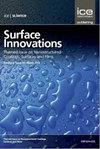离子束对 PVA/TiO2 薄膜表面特征和结构特性的影响
IF 2.7
4区 材料科学
Q3 CHEMISTRY, PHYSICAL
引用次数: 0
摘要
本次研究采用溶液浇铸法制备柔性聚合物复合材料,包括二氧化钛(TiO2)和聚乙烯醇(PVA)。然后,使用宽光束自制冷阴极离子发生器对样品进行 4x1016、8x1016 和 12x1016 离子.cm-2 的氧通量辐照。使用 EDX、接触角和 XRD 技术评估了 PVA/TiO2 复合薄膜的成功生产情况。使用紫外可见光技术报告了离子暴露对光学行为的影响。PVA/TiO2 的分散能为 1.75 eV,在 4x1016、8x1016 和 12x1016 离子.cm-2 的辐照下,分散能分别增至 2.21 eV、2.66 eV 和 3.12 eV。此外,PVA/TiO2 的折射率(n0)从 1.18 分别提高到 1.25、1.32 和 1.40。此外,振荡能 E0 从 PVA/TiO2 复合材料的 4.24 eV 分别降低到 3.84 eV、3.64 eV 和 3.27 eV。因此,离子辐照使 PVA/TiO2 薄膜的光学和结构发生变化,可用于指导经处理的 PVA/TiO2 材料在各种光电中的应用。本文章由计算机程序翻译,如有差异,请以英文原文为准。
Influence of ion beam on the surface characteristics and structural properties of PVA/TiO2 films
This current work using solution-casting preparation method to create flexible polymer composite materials including titanium dioxide (TiO2) and polyvinyl alcohol (PVA). Then, using a wide beam homemade cold cathode ion generator the samples were irradiated by oxygen fluence of 4x1016, 8x1016, and 12x1016 ions.cm−2. Using EDX, contact angle and XRD techniques, the PVA/TiO2 composite film successful production was evaluated. The effects of ion exposure on the optical behavior are reported using UV-Vis technique. The PVA/TiO2 dispersion energy is 1.75 eV, increased to 2.21 eV, 2.66 eV, and 3.12 eV by irradiation of 4x1016, 8x1016, and 12x1016 ions.cm−2. Moreover, the refractive index (n0) of the PVA/TiO2 is 1.18 increased to 1.25, 1.32, and 1.40 respectively. Moreover, the oscillation energy E0 reduced from 4.24 eV for the PVA/TiO2 composite to 3.84 eV, 3.64 eV, and 3.27 eV, respectively. Thus, the changes in the optical and structural alterations in PVA/TiO2 films by ion irradiation, is employ for directed the treated PVA/TiO2 materials in various optoelectronic.
求助全文
通过发布文献求助,成功后即可免费获取论文全文。
去求助
来源期刊

Surface Innovations
CHEMISTRY, PHYSICALMATERIALS SCIENCE, COAT-MATERIALS SCIENCE, COATINGS & FILMS
CiteScore
5.80
自引率
22.90%
发文量
66
期刊介绍:
The material innovations on surfaces, combined with understanding and manipulation of physics and chemistry of functional surfaces and coatings, have exploded in the past decade at an incredibly rapid pace.
Superhydrophobicity, superhydrophlicity, self-cleaning, self-healing, anti-fouling, anti-bacterial, etc., have become important fundamental topics of surface science research community driven by curiosity of physics, chemistry, and biology of interaction phenomenon at surfaces and their enormous potential in practical applications. Materials having controlled-functionality surfaces and coatings are important to the manufacturing of new products for environmental control, liquid manipulation, nanotechnological advances, biomedical engineering, pharmacy, biotechnology, and many others, and are part of the most promising technological innovations of the twenty-first century.
 求助内容:
求助内容: 应助结果提醒方式:
应助结果提醒方式:


